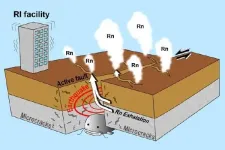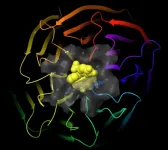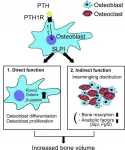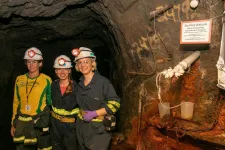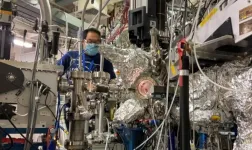(Press-News.org) An international research team led by Monash University has uncovered a new technique that could speed up recovery from bone replacements by altering the shape and nucleus of individual stem cells.
The research collaboration involving Monash University, the Melbourne Centre for Nanofabrication, CSIRO, the Max Planck Institute for Medical Research and the Swiss Federal Institute of Technology in Lausanne, developed micropillar arrays using UV nanoimprint lithography that essentially 'trick' the cells to become bone.
Nanoimprint lithography allows for the creation of microscale patterns with low cost, high throughput and high resolution.
When implanted into the body as part of a bone replacement procedure, such as a hip or knee, researchers found these pillars - which are 10 times smaller than the width of a human hair - changed the shape, nucleus and genetic material inside stem cells.
Not only was the research team able to define the topography of the pillar sizes and the effects it had on stem cells, but they discovered four times as much bone could be produced compared to current methods.
The findings were published in Advanced Science.
"What this means is, with further testing, we can speed up the process of locking bone replacements with surrounding tissue, in addition to reducing the risks of infection," Associate Professor Jessica Frith from Monash University's Department of Materials Science and Engineering said.
"We've also been able to determine what form these pillar structures take and what size they need to be in order to facilitate the changes to each stem cell, and select one that works best for the application."
Researchers are now advancing this study into animal model testing to see how they perform on medical implants.
Engineers, scientists and medical professionals have known for some time that cells can take complex mechanical cues from the microenvironment, which in turn influences their development.
However, Dr Victor Cadarso from Monash University's Department of Mechanical and Aerospace Engineering says their results point to a previously undefined mechanism where 'mechanotransductory signalling' can be harnessed using microtopographies for future clinical settings.
"Harnessing surface microtopography instead of biological factor supplementation to direct cell fate has far-reaching ramifications for smart cell cultureware in stem cell technologies and cell therapy, as well as for the design of smart implant materials with enhanced osteo-inductive capacity," Dr Cadarso said.
Professor Nicolas Voelcker from the Monash Institute of Pharmaceutical Sciences and Director of the Melbourne Centre for Nanofabrication said the study results confirm micropillars not only impacted the overall nuclear shape, but also changed the contents of the nucleus.
"The ability to control the degree of deformation of the nucleus by specifying the architecture of the underlying substrate may open new opportunities to regulate gene expression and subsequent cell fate," Professor Voelcker said.
INFORMATION:
Dr Victor Cadarso and Associate Professor Jessica Frith from Monash University's Faculty of Engineering, and Professor Nicolas Voelcker from the Monash Institute of Pharmaceutical Sciences and Adjunct Professor in Materials Science and Engineering, led the study.
They were supported by James Carthew and Margeaux Hodgson-Garms (Materials Science and Engineering, Monash University); Sara Ghavamian and Hazem Abdelmaksoud (Mechanical and Aerospace Engineering, Monash University); Dr Roey Elnathan (Monash Institute of Pharmaceutical Sciences); Stella Aslanoglou (Melbourne Centre for Nanofabrication); Professor Joachim Spatz (Max Planck Institute for Medical Research); Juergen Brugger (Swiss Federal Institute of Technology in Lausanne); and Dr Helmut Thissen (CSIRO).
To download a copy please visit https://onlinelibrary.wiley.com/doi/10.1002/advs.202003186
MEDIA ENQUIRIES
Leigh Dawson
T: +61 455 368 260 E: media@monash.edu
The concentration of the radioactive element radon is known to change in the ground before and after earthquakes. Previous studies have shown elevated radon levels in the atmosphere before the mainshock of a large inland earthquake due to foreshock activity and slow slip.
But now, researchers from Tohoku University have revealed an anomaly in this phenomenon. Through the analysis of data before and after the 2018 Northern Osaka Earthquake, they discovered that the atmospheric radon concentration decreased.
The results of their research were published online in Scientific Reports on April 2, 2021.
"For the first time, we found a decrease in the atmospheric radon associated with seismic quiescence before the mainshock of ...
A team from the Department of Agronomy at the UCO has demonstrated, through field tests carried out during 8 agricultural seasons, that foliar feeding with fertilizer increases the concentration of zinc in wheat more than if it is applied to the soil
Micronutrient deficiencies pose health problems for a third of the world's population. Worldwide, zinc deficits are more problematic in the rural areas of developing countries, where diets are largely limited to vegetable products grown in soils suffering from low nutrient availability. Biofortification, the process of bolstering the nutritional value of crops by increasing ...
Researchers at the Obesity Research Unit of the University of Helsinki have found that obesity clearly reduces mitochondrial gene expression in fat tissue, or adipose tissue. Mitochondria are important cellular powerplants which process all of our energy intake. If the pathways associated with breaking down nutrients are lazy, the changes can often have health-related consequences.
A total of 49 pairs of identical twins discordant for body weight participated in the study conducted at the University of Helsinki: their body composition and metabolism were studied in detail, and biopsies from adipose and muscle tissue were collected. Multiple techniques for ...
WASHINGTON, April 9, 2021 -- For the millions of people worldwide who have sickle cell disease, there are only a few treatment options, which include risky bone marrow transplants, gene therapy or other treatments that address a subset of symptoms. Today, researchers will describe the discovery of a small molecule with the potential to address the root cause of sickle cell disease by boosting levels of fetal hemoglobin, a healthy form that adults normally do not make. The drug could be formulated into a convenient daily tablet.
The researchers will present their results today at the spring meeting of the American Chemical Society (ACS). ACS Spring 2021 is being held online April 5-30. Live sessions will be hosted April 5-16, and on-demand and networking content will continue through ...
Osaka, Japan - Despite what some people think, bone is not merely a passive component of the body. The skeleton is structurally dynamic and responds to life's physical stresses with continual equilibration between bone mass loss and reformation. This ensures healing and remodeling in tune with the ebb and flow of calcium and phosphorus in the bloodstream. Now, researchers at Osaka university have identified a molecule--secretory leukocyte protease inhibitor (SLPI)--that helps mediate this critical balance, which could be used in the development of new treatments for bone diseases such as osteoporosis.
Skeletal tissue changes are orchestrated ...
Exercise and a healthy diet in childhood leads to adults with bigger brains and lower levels of anxiety, according to new UC Riverside research in mice.
Though diet and exercise are consistently recommended as ways to promote health, this study is the first to examine the long-lasting, combined effects of both factors when they are experienced early in life.
"Any time you go to the doctor with concerns about your weight, almost without fail, they recommend you exercise and eat less," said study lead and UCR physiology doctoral student Marcell Cadney. "That's why it's surprising most studies only look at diet or exercise separately. In this study, we wanted to include both."
The researchers determined that early-life exercise generally reduced anxious behaviors ...
Obesity is linked to heavier periods and may be caused by delayed repair of the womb lining, according to a study published in the Journal of Endocrinology. Using a combined approach, assessing both women and mice, the study suggests an association between higher body weight and greater menstrual blood loss that may result from increased inflammation in the womb lining, delaying its repair. Although the study did not examine whether weight loss or anti-inflammatory medications may be useful in treating women with obesity and heavy periods, this is a step towards developing more successful ...
Below the verdant surface and organic rich soil, life extends kilometers into Earth's deep rocky crust. The continental deep subsurface is likely one of the largest reservoirs of bacteria and archaea on Earth, many forming biofilms - like a microbial coating of the rock surface. This microbial population survives without light or oxygen and with minimal organic carbon sources, and can get energy by eating or respiring minerals. Distributed throughout the deep subsurface, these biofilms could represent 20-80% of the total bacterial and archaeal biomass ...
Early results show that a new combination drug therapy is safe and effective against advanced skin cancer in patients who were not able to have their tumors surgically removed.
The drug combination is among the first, researchers say, to demonstrate the potential value of a live common cold virus, a coxsackievirus, to infect and kill cancer cells.
The Phase I study, led by a researcher at NYU Langone Health and its Perlmutter Cancer Center, is also among the first to show how such oncolytic viruses can safely boost the action of widely used cancer therapies that help the body's immune defense system detect and kill cancer ...
An international team working at the U.S. Department of Energy's Lawrence Berkeley National Laboratory (Berkeley Lab) used a unique X-ray instrument to learn new things about lithium-rich battery materials that have been the subject of much study for their potential to extend the range of electric vehicles and the operation of electronic devices.
The researchers focused their investigations on a material called lithium manganese oxide (Li2MnO3), the extreme example of so-called "lithium-rich" materials, containing the largest amount of lithium possible within this family of materials. A recently developed tenet of the ...
